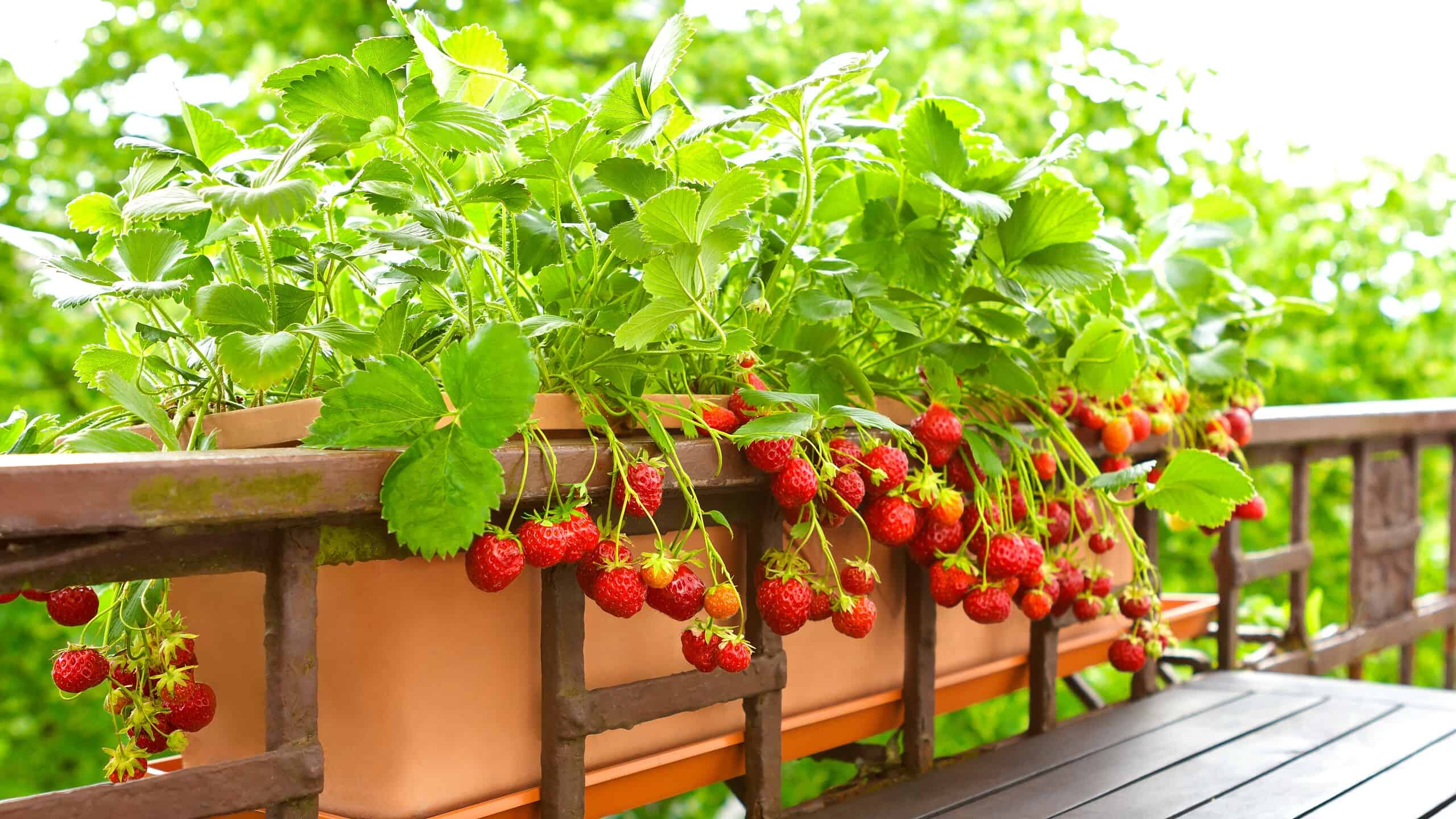The strawberry, a vibrant red gem of a fruit adorning gardens and tables alike, has long enchanted our palates. A hybrid of wild Virginia and Chilean varieties, this fruit has seduced emperors and empresses, inspired chefs, and intrigued linguists. Its allure is timeless, bridging cultures and generations with its sweet, succulent taste. But beyond its culinary appeal lies an intriguing question—where did the word “strawberry” come from?
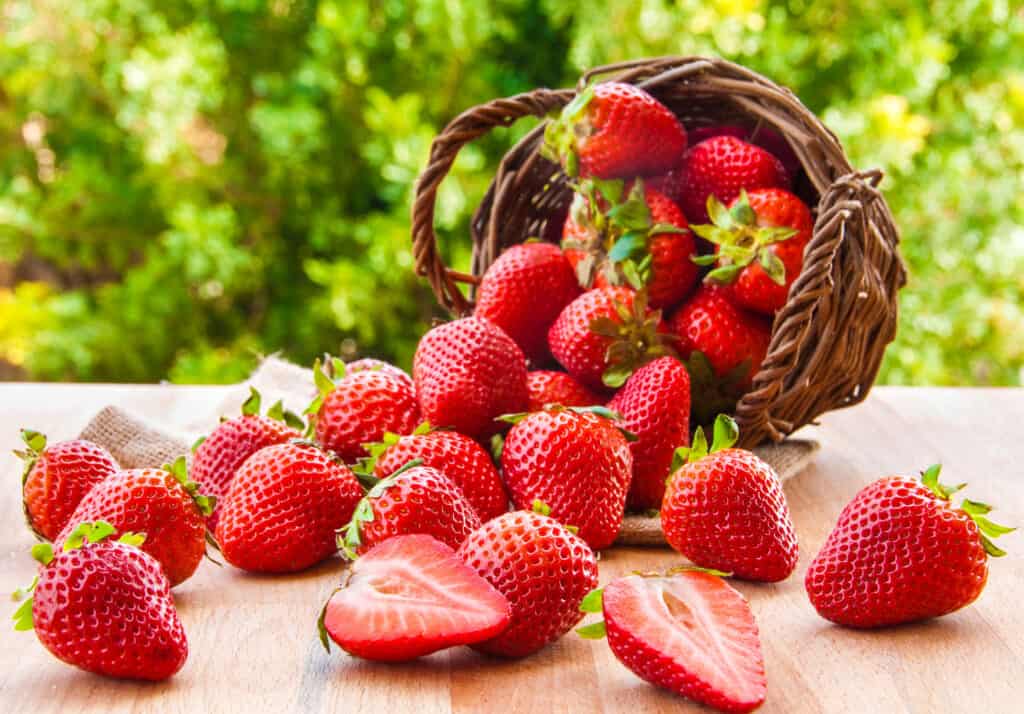
You can grow strawberries in many climates, but they thrive most in states like California and Florida, as well as the Northeastern US
©iStock.com/MariaUspenskaya
Theories About the Name “Strawberry,” aka “Debate-berry”
The origin of the word “strawberry” has intrigued scholars and etymologists alike, sparking multiple theories that explore possible connections and derivations. Here’s a closer look at the prominent theories:
The Old English Connection Theory
Some believe that the plant’s unique growth habitat is the source of the term “strawberry.” Its runners stray in all directions, appearing scattered or “strewn,” which possibly relates to the Old English word “strēaw.” This connection to “strēaw,” meaning “to strew,” is one interpretation that has led to the term “strawberry.”
Stray Berry Theory
Closely linked to the first theory, people often cite another explanation known as the “strewn berry” theory. It underscores the appearance of the berries as if strewn across the ground. This scattered appearance further reinforces the association with “stray” berries, creating a similar origin story.
In Bed With the Berry Theory
Among various other theories proposed, one intriguing idea suggests that the practice of bedding strawberries in straw could be the root of the name. However, experts at Oxford University have debunked this theory, highlighting that the word’s existence predates such cultivation practices. Further, other theories explore connections to the straw-like appearance of the stems or alternative cultivation methods involving straw.
The truth behind the word “strawberry” remains out of reach, leaving plenty of room for fruitful speculation and scholarly debate. The web of theories fails to find a fixed center around a concrete name origin. There are a host of other theories. It’ll be some time until enough research confirms or rejects theories conclusively. Or maybe the etymology of “strawberry” is lost to time, and the origins of the name will forever remain a delicious mystery.

Honored here on the Swedish 100 krona, botanist and “father of modern taxonomy” Carl Linnaeus was instrumental in ridding Europe of its superstitious antipathy toward strawberries
©Prachaya Roekdeethaweesab/Shutterstock.com
A Historical Cornucopia: The Strawberry Through the Ages
Origins of the Strawberries We Eat Today
Modern strawberries are hybrids from New England and Chile, introduced into France in the early 18th century.
Ancient Beliefs
Strawberries declined in popularity starting in the 12th Century due to superstitions. These demons were later dispelled by botanist Carl Linnaeus.
Influence of Royalty
King Charles V’s strawberry plants in the Royal Gardens of the Louvre added prestige to the fruit.
Renaissance to Modern Era
Flourishing in Europe and New York by the 19th century, refrigeration in 1843 helped extend the strawberry’s reach.
Wartime Delight
During World War II, strawberries uplifted soldiers’ morale.
Cultural Significance of the Strawberry
Symbol of Love
Linked to Venus, the Roman Goddess of Love, the strawberry’s red color and heart shape have fostered associations with romance.
Symbol of Healing
In traditional medicine, people considered the strawberry a remedy for ailments like digestive problems and skin conditions.
Religious Symbolism
Revered in the Middle Ages as a symbol of the Virgin Mary, the strawberry also represented “perfect righteousness,” “good works,” and modesty.
Erotic Symbolism
Artists, such as Hieronymous Bosch in “Garden of Delights,” depict the strawberry’s voluptuous nature. Most likely, Bosch connected Venus, who in addition to being the Roman goddess of love was also the goddess of beauty, desire, sex, fertility, and victory.
Nobility
Strawberry leaves signify princes and higher ranks, appearing on coronets.
Cultural Interpretations
Artworks like “The Little Garden of Paradise,” a painting from around 1410 by an unknown Upper Rhenish Master, with its detailed depiction of fruit, highlight the dual imagery of purity and sin associated with strawberries (purity, in this case).
Literary References
Symbolizing sensuality in Thomas Hardy’s Tess of the D’Urbervilles and appearing in Shakespeare’s Othello, the strawberry has rich literary symbolism.
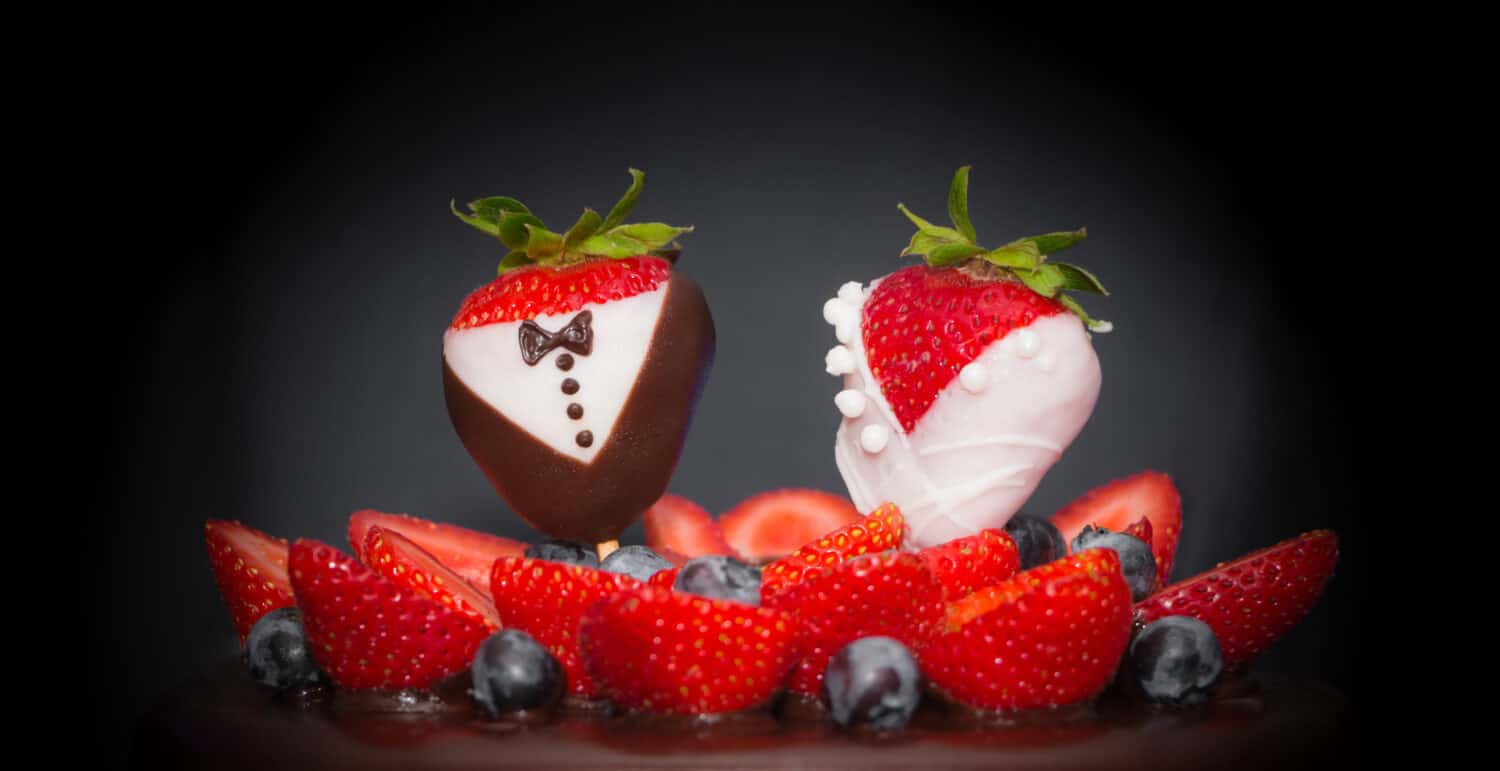
As a symbol of love, strawberries are often elaborately presented at weddings
©azur13/Shutterstock.com
The Strawberry in Folklore and Traditions
Wedding Traditions
Symbol of love and fertility.
German Folk Beliefs
Sharing a double strawberry can lead to love.
Native American Traditions
Representing rebirth and new beginnings.
Popular Culture
Strawberry Fields Memorial
A symbol of peace and love in New York City’s Central Park, it pays homage to the late Beatle John Lennon, who wrote the song “Strawberry Fields Forever” there.
Valentine’s Day
Associated with romantic love, especially when dipped in chocolate.
Film References
On the silver screen, they’ve represented love and freedom in films like Across the Universe (2007).
Architecture
Strawberry Hill House: A Gothic Revival villa reflecting purity, whimsy, and nostalgia.
Strawberry Botanical Information
Species and Classification
Strawberries belong to the genus Fragaria, with the most common cultivated species being Fragaria × ananassa, a hybrid of two wild species. Different regions grow various other species and subspecies, reflecting the strawberry plant’s diversity and adaptability.
“False Fruit”: Understanding the Unique Classification
The classification of strawberries as “false fruits” or pseudocarps, rather than true berries, can make their categorization somewhat confusing. In the botanical world, the definition of fruits and vegetables is more specific and sometimes different from our common understanding. People typically define fruits as the mature ovaries of seed-bearing plants, while they cultivate vegetables for their other edible parts. Interestingly, some foods we think of as fruits, like rhubarb, don’t fit the botanical definition of fruit, while some vegetables, like tomatoes and avocados, are classified as fruits.
People categorize strawberries as multiple fruits because their seeds are found on the outside, rather than being contained within a single ovary. Despite this unique classification, many cherish them for their delightful flavor and versatile culinary uses.
Appearance
The strawberry plant produces lush green leaves (that look as if “strewn” across the ground) and delicate white flowers before bearing the bright red fruit that we know and love today. The “seeds” on the surface of the strawberry aren’t true seeds. Rather, they’re individual tiny fruits called achenes, each containing a seed, adding to the complexity and appeal of the fruit.
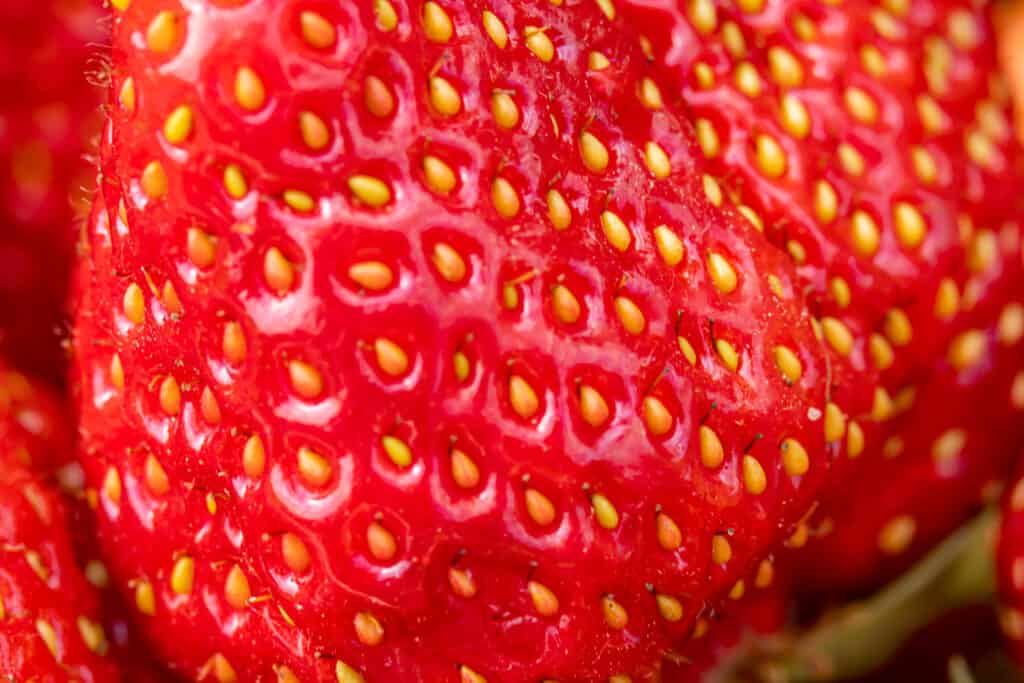
Achenes on the strawberry skin each contain their own seeds
©iStock.com/Oleg Prolat
Cultivation
Cultivating strawberries requires a delicate balance of factors, including climate, soil, and plant-specific care. While strawberries thrive in temperate climates, 76 countries, including the Northeast United States, grow them commercially. In these regions, strawberries have a high value per acre and provide early season income for diversified vegetable and berry farms. Key considerations include soil quality, temperature, sunlight, and water, with technological advancements enhancing production and quality.
Early History
Origins trace back to the first century CE with the Alpine and Musk strawberry. However, Virgil and Ovid wrote about strawberries for their ornamental functions, not as an edible fruit.
Native Varieties
Indigenous peoples cultivated several varieties of strawberries. They were popular with the early colonists and later shipped to Europe. In the Northeast, these indigenous varieties played a significant role in the local economy and culture.
Renaissance to Victorian Era
Cultivation spread from the Renaissance period, with the Victorian era witnessing large-scale breeding. During this time, French and English breeders developed the modern strawberry variety, Fragaria ananassa, through the hybridization of the Virginia and Chilean strawberries.
California’s Role
California grows 75 percent of the North American crop, benefiting from the state’s diverse climates. Meanwhile, the Northeast United States has maintained its role in strawberry cultivation, producing different varieties and contributing to the industry’s evolution.
Hybridization and Breeding
Modern strawberry cultivation has benefited from extensive hybridization and breeding programs, including work since 1920 by breeders at federal or state experiment stations. This scientific innovation extends the growing season, increases yield, and allows for the cultivation of strawberries in new regions, with significant historical developments:
Hybridization
Today’s strawberries derive from 17th & 18th-century crosses of wild species, mainly from the Northeastern US and Europe, but also including the Chilean strawberry. A French spy smuggled the Chilean strawberry to France in 1714.
20th Century Techniques
Introduction of virus-free stocks and modern hybrids, with George M. Darrow, a Vermonter and prolific USDA researcher, playing a significant role in improving the disease resistance of strawberries and developing new varieties.
Popular Cultivars
Today, some of the most notable and widely grown strawberry cultivars include:
Junebearing Varieties
Includes Honeoye, Earliglow, Allstar, Chandler, and Jewel
Day-Neutral Varieties
Albion, Monterey, and San Andreas
Everbearing Varieties
Ozark Beauty, Quinault
Wild or Specialty Varieties
Mara des Bois, Fragaria vesca (Alpine Strawberry).
Hydroponic or Greenhouse Varieties
Elsanta is an example of this new-fangled technique

You can’t go wrong starting your day off with a strawberry yogurt cream jam pancake tower
©Fra tta/Shutterstock.com
Strawberry in the Culinary World
Culinary Uses
Strawberries are celebrated for their delightful taste and versatility in culinary creations. Here’s a comprehensive look at their use:
Fresh and Savory
Eaten on their own (especially good when just picked) or with a sprinkle of sugar or cream
Strawberry Spinach Salad, Strawberry Salsa, Strawberry Gazpacho
Sweet Treats and Desserts
From strawberry shortcake to tarts, ice creams, cheesecake, and chocolate-dipped strawberries
Beverages
Smoothies, cocktails like Strawberry Margarita, or refreshing Strawberry Lemonade
A Splash of Color to Start Your Day
Strawberry Pancakes, Parfait, and Jam and Preserves
Creative Culinary Fusion
Strawberry Balsamic Glaze and Strawberry Risotto (yes, it exists)
Classic and Modern Strawberry Cocktails
Including Strawberry Mojito, Frozen Strawberry Daiquiri, and Strawberry-Rhubarb Gin Fizz
Strawberry-Based Alcohol
Strawberry Wine, Liqueurs, Brandies, and Vodka
Strawberries Around the World
Culinary Uses of Strawberries in Japan: A Fusion of Luxury and Tradition
Strawberry growth and utilization in Japan are no exception to the country’s culinary expertise. Strawberries’ use in a variety of Japanese desserts and dishes demonstrates their culinary diversity, quality, and reputation as a premium item.
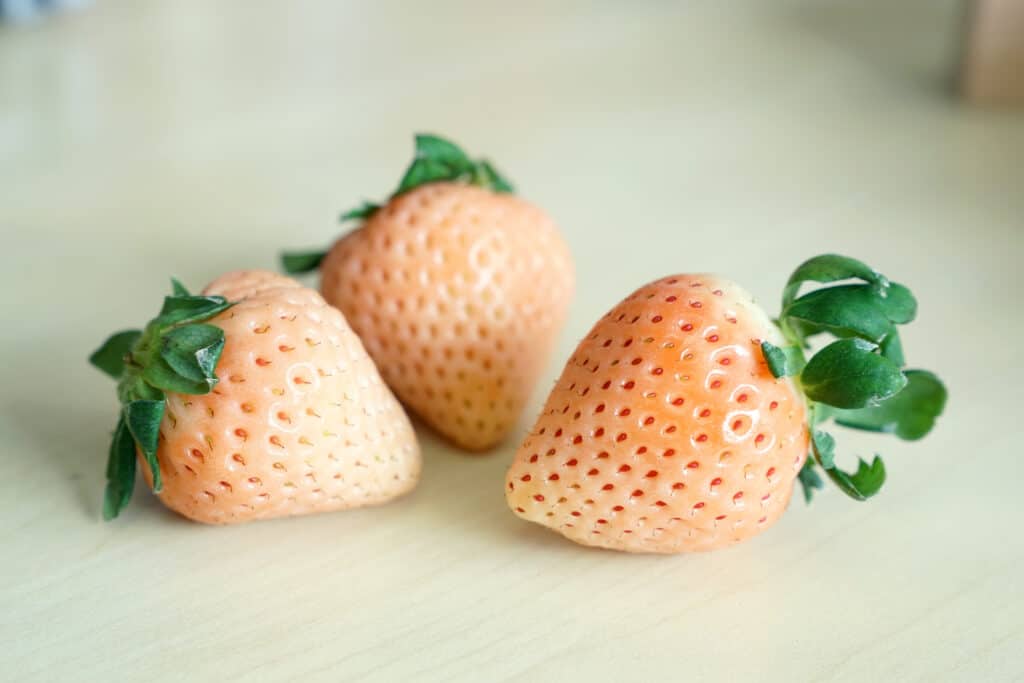
The white jewel strawberry, a luxury fruit from Japan, despite appearances, is sweeter other strawberries
©Esmond Poh/Shutterstock.com
A Luxury Status
The Japanese associate Japanese strawberries with luxury, acclaiming them for their quality, beauty, and taste. Farmers grow these berries all year, with the peak season for conventional strawberries being from May to June and for specific premium types being from December to May. Due to their quality and romantic appeal, the luxury strawberry market offers uncommon and distinctive shapes such as gigantic berries and lovely white strawberries, all of which can fetch high prices in department stores.
Traditional Desserts
Strawberries are not only eaten fresh from the vine in Japanese cuisine, but they are also used in a variety of traditional desserts. Ichigo Daifuku, a popular Japanese dessert dating back to the 1980s, is a great example. It mixes soft mochi, sweet red bean paste, and luscious strawberries for a delicious flavor and texture fusion. It is available in a variety of tastes, including custard cream, white bean paste, strawberry and cream, matcha, sakura, and sweet potato.
Strawberry Mochi, also known as Ichigo Daifuku, is a springtime treat prepared from soft and chewy mochi packed with fresh strawberries and sweet red bean paste. It represents the spirit of Japanese culinary expertise, combining various textures and flavors to produce a one-of-a-kind eating experience.
Modern Inventions
Fruit sandwiches, often known as fruit sando or strawberry sando, are examples of current Japanese culinary inventiveness. These delectable sandwiches are made with fresh strawberries, fluffy milk bread, and whipped cream, and make an ideal summer treat. The presentation is critical, with the fruit arranged in a mosaic arrangement that becomes visible when the sandwich is split in half. This visual appeal enhances the experience by emphasizing Japan’s creative approach to eating.
French Strawberries: The Many Shapes of Flavor
Strawberries are more than simply a fruit in France; they are a symbol of spring and summer, adored for their distinct flavors and variety. Here’s an inside look at the world of French strawberries:
Gariguette
Appearance: Thinner, longer oval form
Available from March till mid-June
Flavor: It has a pleasant and fragrant flavor
La Charlotte
Appearance: round, bulbous form.
Available from May until mid-November.
Frequently used in sweets and pastries.
La Ciflorette
Appearance: Long and round, similar to Gariguette
Available from March until July.
Mostly found in southern France.
La Mara des Bois
Appearance: Rounder in shape
Available from mid-May till October
Similar taste to Fraise du Bois but less expensive.
Fraise des Bois
Appearance: Tiny, but flavorful.
Season: Typically, April.
Known as the “Rolls Royce” of strawberries, it is frequently seen in high-end dessert shops.
Rich and savory, it’s considered a great delicacy.
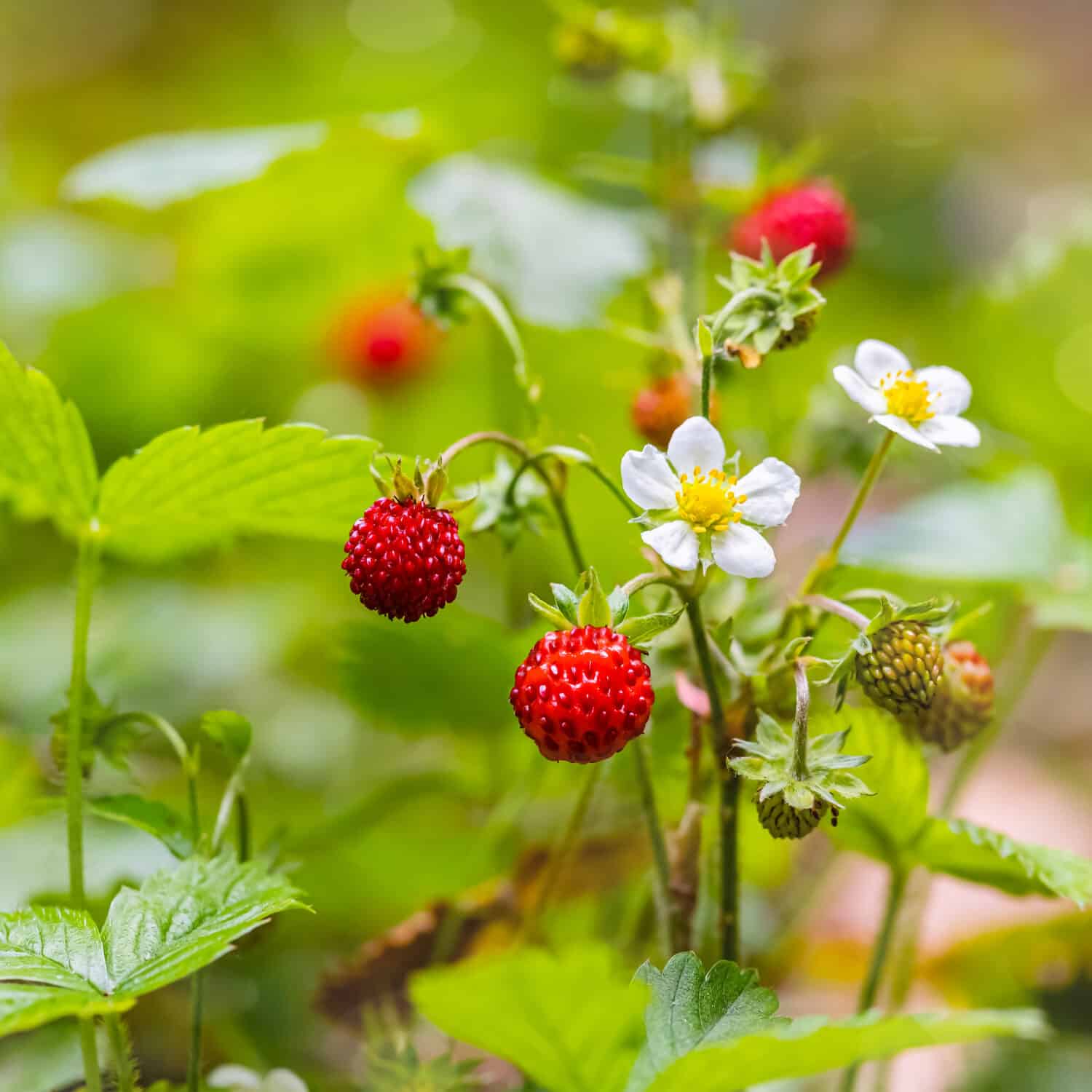
Fraise des bois, more commonly known as wild strawberries, are small and rich in flavor
©nnattalli/Shutterstock.com
Pastries & Desserts
French strawberries are frequently used in tarts, cakes, and pastries to provide a touch of elegance and flavor.
Strawberries in Italian Cuisine (Fragole)
Tarts, Jams, and Gelati, Oh My!
Strawberries are commonly used in Italian desserts, including tarts, jams, and gelato.
When Served Plain
Often served plain, dressed with orange or lemon juice, red or white wine, or balsamic vinegar, particularly near Modena.
Pasta Dishes
Strawberries are even used in pasta dishes, such as “Spaghetti alle Fragole.”
Strawberry Curry: A Modern Twist on Tradition
A British twist on a long-standing South Asian tradition, strawberry curry is a contemporary Indian dish that celebrates the seasonal produce of strawberries.
Other Strawberry Uses in Indian Cuisine
Strawberry Lassi
A delicious soothing sweet yogurt smoothie, flavored with strawberries.
Strawberry Peda
A variation of the traditional Indian sweet, Peda, with the addition of fresh strawberries.
Strawberry Phirni
A creamy dessert prepared with full cream milk, soaked rice paste, sugar, cardamom, and sliced pistachios, flavored with strawberries.
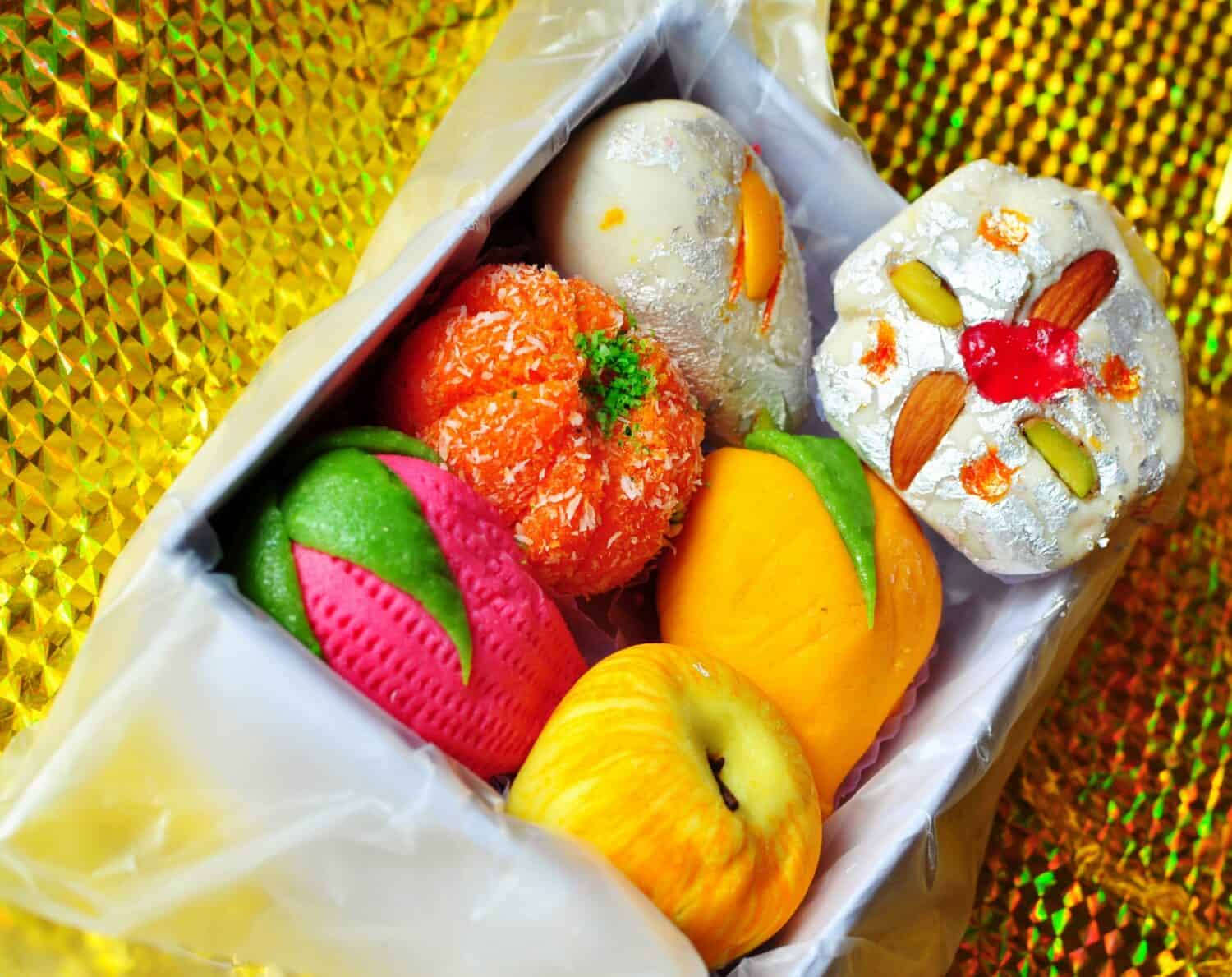
Boxes of sweets are popular during Diwali, the Hindu festival of light, to which the strawberry has made its way
©silentwings_M_Ghosh/Shutterstock.com
Nutritional Value
Hungry yet? You’re in luck, since strawberries are not only tasty, but are also healthy. They’re rich in vitamins, minerals, and antioxidants. Their various health benefits include:
Vitamin C
Boosting immunity and skin health
Fiber
Aiding in digestion and cholesterol management
Antioxidants
Fighting free radicals and inflammation
Low on the Calories
Perfect for weight management
Heart Health
Supporting heart health through anti-inflammatory and cholesterol-lowering effects
Pairings: Strawberries, the Flavor of Versatility
Many people enjoy making an occasion of eating strawberries. Like other delicacies, it’s best enjoyed paired with other foods or drinks. And, of course, friends and family —even their dogs! Consider the following pairings next time you hit the strawberry jackpot:
Wine and Strawberries
Fresh Strawberries with Rose of Pinot Noir, Chocolate-Covered Strawberries with Maury, and more
Healthier and Alternative Pairings
Enhance with fruit-flavored liqueurs or Cointreau
Unusual but Delicious: Strawberries with Cheese
Winning flavor combinations like Chimay Doré and Chavroux will win over the cheese-cautious
A Summer Delight: Berry Cheese Board
Featuring strawberries with goat cheese, sharp white cheddar, and whipped honey ricotta can really up your snack-board game

Earthy wines and fresh strawberries pair well
©Photographer_ME/Shutterstock.com
Economic Impact of Strawberries
Beyond the indulgences of the senses, strawberries contribute to the global economy in several ways. Below, we look at some of the most significant economic impacts of these freshest of commodities.
Global Production of Strawberries
Strawberries are produced commercially in 76 countries, making them a significant player in the global fruit market. The largest producer is China, followed by the USA, Mexico, Turkey, and Spain. Production continues to increase, particularly in Asia, North and Central America, and North Africa, with a matching increase in demand in many parts of the world.
Widespread Strawberries: Global Distribution and Trade
California’s Role
California produces over 91 percent of the US strawberry crop. The state’s unique climate and soil conditions have made it a hub for strawberry cultivation. But growers are facing several challenges in balancing mass production with sustainability.
What the Bubbleberries?!
An interesting development in the strawberry market is the introduction of “bubbleberries,” which resemble small strawberries but taste like bubblegum.
Technological Advancements
Plant breeding and technological innovations have played a pivotal role in expanding strawberry cultivation. By developing disease-resistant varieties and optimizing growing conditions through controlled environments, technology has enhanced yields, quality, and sustainability. Innovations such as vertical farming and hydroponics are paving the way for urban agriculture, making strawberries accessible to new markets.
Technology and the Shape of Strawberries
An exciting development in the world of strawberries is the use of technology to study and understand their shapes. Scientists have used computers and special algorithms to analyze pictures of strawberries, classifying them into different shape categories. This might sound technical but think of it like sorting strawberries into groups based on how they look.
By looking at 68 different characteristics of each strawberry, like how round or long they are, the researchers were able to classify the shapes with impressive accuracy, ranging from 68% to 99%. This helps farmers and breeders understand the strawberries better and can be used to make them grow in more appealing shapes.
What’s even more fascinating is that this technology isn’t limited to strawberries. It could be used to study the shapes of other fruits, vegetables, and specialty crops as well, giving new insights into how these plants grow.
Strawberries and Environmental Considerations
As is often the case, good things come at a cost. As we grapple with environmental challenges and an expanding human population that must share limited resources, the impacts of strawberry production increases.
Environmental Impact of Strawberry Cultivation
High Irrigation Requirements
Strawberries require high amounts of irrigation, pesticides, harmful nitrogen fertilizers, and plastic packaging, leading to a high carbon footprint.
Land Requirements
Strawberries’ land requirements are fairly average, but they are planted in monocultures, contributing to habitat loss.
Water Footprint
Strawberries have a fairly high water footprint of 50 to 75 inches of water per year, mostly from irrigation.
Agrochemical Usage
High pesticide and fertilizer usage is associated with strawberries, leading to environmental destruction.
Sustainable Practices in Strawberry Farming
In response to the various environmental challenges linked to strawberry cultivation, fruit growers are increasingly adopting sustainable practices aiming to mitigate these negative impacts. Some practices include:
Water Conservation
Efficient irrigation systems and water management strategies are implemented to address the substantial water needs of strawberries.

When the old ways are new again: advances in organic farming techniques are finding their place in the broad spectrum of solutions to environmental problems
©Melinda Nagy/Shutterstock.com
Organic Farming
By avoiding synthetic pesticides and fertilizers, farmers are focusing on natural soil enrichment to enhance soil quality.
Integrated Pest Management (IPM)
Using biological controls and careful monitoring to reduce the need for chemical pesticides, this approach lessens the potential harm to soil and water.
Crop Rotation and Polyculture
These practices enhance soil health, reduce pest pressure, and increase biodiversity.
These sustainable practices not only address the immediate environmental concerns but also pave the way for a more ecologically responsible future in strawberry farming. In fact, we can better enjoy them knowing they aren’t hurting the planet and draining excess resources.
Community and Consumer Engagement
The movement towards sustainable strawberries is not limited to farmers but includes consumers and communities:
Farmers’ Markets and Local Sourcing
Supporting local growers who practice sustainable farming will help grow the responsible side of the industry.
Certifications
Look for certifications like Organic, Fair Trade, or Rainforest Alliance to choose responsibly grown strawberries.
Educational Outreach
Many farms offer tours and workshops to educate the public about sustainable agriculture. Additionally, those interested in learning the art and craft of sustainable agriculture can participate in intensive apprenticeships like the ones offered by California’s Center for Land-Based Learning.
Conclusion: Stop and Smell (and Taste) the Strawberries
Strawberries, the “false fruit” that we just can’t enough of, are more than just a visual treat. Each bite contains the richness of history, culture, science, economy, and ecology. The exploration of the strawberry world is one of discovery and appreciation. It’s an invitation to take a moment to appreciate not only the sweetness of the fruit, but also the richness of its existence — ours and theirs both.
Thank you for reading! Have some feedback for us? Contact the AZ Animals editorial team.

